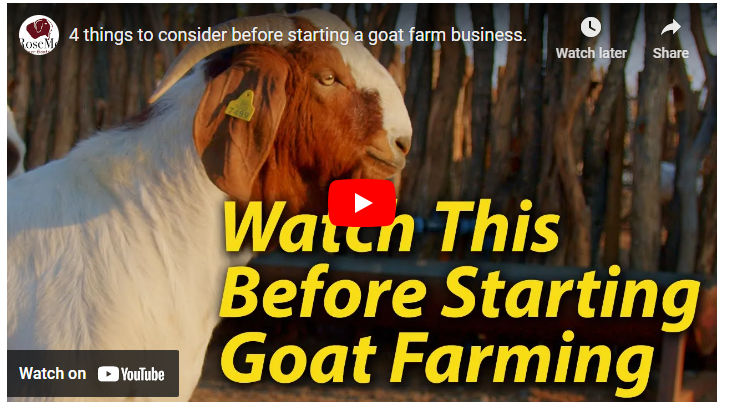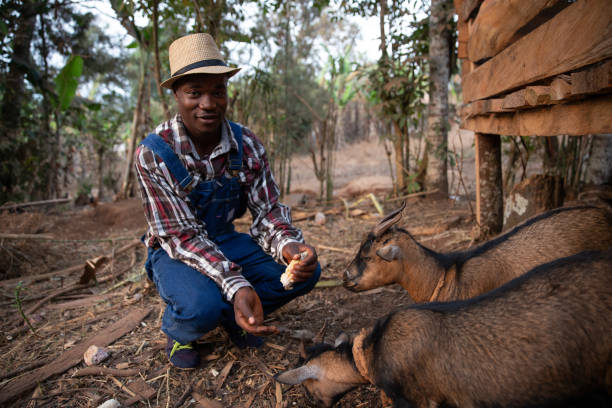Goat farming is gradually becoming a one of the profitable farming in the United States of America. Today, we will be sharing some guide on how to start goat farming in the USA, Goat Breeds, Business Plan To Raise Goats in the USA.
Also, we will be sharing the best bread for meat and dairy. This will guide you to knowing what exactly you want as a goat farmer or livestock farmer.
First before we continue let us look what a goat are used for in the US, this will help us focus our energy on profitable things. Aside from that, we will also talk about what a goat is.
About Goats
What are Goats Used for in US?
Before you go into goat farming you must first know why you are going into this type of farming.
-
Fiber Production from Goats in the USA
-
Raising Meat
- Dairy
Difference between Raising Meat Goats and Dairy Goats in the USA
Here are some of the difference between meat goats and dairy goats;
Dairy Goats
When it comes to body shape and size, dairy goat breeds typically exhibit tall stature and long legs. Among these breeds, the Saanen goat stands out as exceptionally profitable. With the ability to yield up to 3 gallons of milk per day, Saanen goats have earned their reputation as the most sought-after dairy goat breed globally.
Here’s a curated list of top goat breeds renowned for their milk production:
- Nigerian Dwarf Goat
- Nubian Goat
- LaMancha Goat
- Saanen Goat
- Alpine Goat
- Oberhasli Goat
Before you decide on a specific goat breed for milk production, it’s crucial to consider several factors:
- Demand: Assess the market demand for goat milk in your area.
- Milk Yield: Evaluate the quantity of milk each breed can produce.
- Taste and Quality: Consider the flavor and overall quality of the milk produced.
- Versatility: Determine the milk’s suitability for cheese, soaps, and other related products.
- Cost Analysis: Compare the expenses involved in raising the goats against the potential profits they can generate.
By weighing these factors carefully, you can make an informed decision that aligns with your goals and aspirations in goat farming.
Meat Goats
When it comes to meat goat breeds, certain types stand out as farmer favorites. Among them, the Boer goat reigns supreme, propelling the global goat meat export industry to new heights. What makes meat goat farming so appealing is its efficiency — these goats require less time, effort, and investment to raise compared to other livestock.
The Boer goat, in particular, is hailed as the pinnacle of meat goat breeds due to its exceptional meat yield and ease of care. With mature bucks weighing between 200 to 340 pounds, Boer goats offer substantial meat production per animal.
Here’s a roundup of the top meat goat breeds prized by farmers:
- Black Bengal Goat
- Boer Goat
- Kalahari Red Goat
- Kiko Goat
- Fainting Goat
- Nubian Goat
- Rangeland Goat
- Sirohi Goat
- Spanish Goat
- Verata Goat
These breeds represent the cream of the crop when it comes to meat goat farming. Whether you’re a seasoned farmer or new to the game, raising these goats promises both profitability and ease, making them an excellent choice for your agricultural endeavors.
Profitable Goat Breeds to Raise in the USA
The world of goats boasts a diverse array of breeds, each serving multiple purposes ranging from milk and meat production to fiber and skins. In the United States alone, the goat population encompasses various types, including Angora, meat, and dairy breeds, totaling over 2.9 million head.
Angora goats are predominantly found in regions like southwest Texas, northeast Arizona, and northwest New Mexico, where climatic conditions and terrain favor their production.
Let’s explore some prominent dairy goat breeds thriving in the USA:
- Alpine: Originating from the Alps, Alpine dairy goats feature upright ears and a dished face, producing an average of 1,500 to 1,600 pounds of milk per year.
- LaMancha: Known for their high butterfat percentage milk, LaMancha goats come in diverse colors and are a versatile choice for dairy farming.
- Nigerian Dwarf: Compact in size yet efficient in milk production, Nigerian Dwarf goats are ideal for those seeking dairy animals in a small package.
- Nubian: With a wide range of colors and distinct characteristics, Nubian goats rank among the most popular dairy breeds in the U.S.
- Saanen: Recognizable by their solid white or cream-colored coat and dished face, Saanen goats hold the title for highest milk production worldwide, averaging 1,800-2,000 pounds per year.
- Toggenburg: Sporting a characteristic mousy brown color pattern, Toggenburg goats offer consistent milk production, averaging 1,500 to 1,600 pounds per year.
On the meat goat front, several breeds excel in the USA:
- Boer: Renowned for their fast growth rate and superior carcass qualities, Boer goats dominate the meat goat industry globally.
- Kiko: Valued for their rapid growth and high fertility, Kiko goats are a preferred choice for meat production.
- Myotonic: Commonly known as Tennessee fainting goats, Myotonic goats exhibit unique fainting behavior and are raised primarily for meat.
- Savanna: A newcomer to the U.S., Savanna goats boast large frames and robust musculature, making them ideal for meat production.
- Kinder: Medium-sized and versatile, Kinder goats offer various color varieties and are suitable for both meat and dairy purposes.
- Pygmy: Admired for their small size and hardiness, Pygmy goats are often kept as pets or raised for meat.
- Spanish: Originally hailing from Spain, Spanish goats are prized for their meat production and brush-clearing capabilities, making them valuable assets in farming operations.
With such a rich diversity of goat breeds, farmers have ample choices to suit their specific needs, whether for dairy, meat, or other purposes.
Best Goat Breeds to Choose for Fiber
Here are some of the goat breeds to rare for fiber;
Steps to Start Goat Farming in the USA
Starting a goat farm comes with its share of challenges, but with careful planning, you can overcome them and set yourself up for success. Before diving into the world of goat farming in the USA, it’s crucial to consider several key elements:
Choosing the Right Location:
Finding a suitable location is paramount for a thriving goat farm. Goats thrive in open spaces, so prioritize areas where they can roam freely. Opt for locations away from urban centers to minimize pollution impact and ensure compliance with local regulations.
Building Shelter for Your Goats:
Housing plays a vital role in goat farming. While goats are hardy creatures, they need shelter from rain and cold winds. Construct sturdy shelters to protect them from the elements and predators, ensuring adequate ventilation and light.
Selecting the Right Goat Breeds:
Choosing the appropriate goat breeds is essential for the success of your farm. Consider your goals—whether it’s milk, meat, or fiber production—and select breeds accordingly. Popular choices include Nigerian Dwarf, La Mancha, Alpine for milk; Boer, Spanish, Tennessee for meat; and Angora, Cashmere for fiber.
Implementing Effective Fencing:
Fencing is crucial to keep your goats safe and secure. Opt for sturdy fencing that prevents escape and keeps predators at bay. Regularly inspect fences for any signs of damage or weakness.
Proper Feeding and Watering:
Providing quality food and clean water is essential for the health and productivity of your goats. Ensure easy access to fresh water and offer balanced nutrition, including calcium and phosphorus supplements as needed. Regular feeding schedules and proper feeding height are also important considerations.
Healthcare and Management:
Proper care and management are key to maintaining the well-being of your goats. Vaccinate them against common diseases and establish a good relationship with a veterinary doctor. Separate kids, bucks, and does, and maintain cleanliness in housing and feeding areas to prevent health issues.
Remember, successful goat farming requires dedication, attention to detail, and a proactive approach to address challenges as they arise. With proper planning and care, your goat farm can thrive and become a rewarding venture.
Common Diseases That Affect Goats
In our previous post we listed some diseases that affect goats and how you can treat them you can do well to check it out.
Also, these are the viral diseases goats must be immunized for; Goat pox with 1 ml dosage Foot and mouth diseases with about 2 ml dosage Anthrax with 1ml dosage Brucellosis with 1ml dosage.
As we said early to know more about other diseases do well to check our post on it.
In Conclusion
In conclusion, going on the journey of goat farming in the USA holds so much potential for those willing to invest time, effort, and careful planning. By first considering crucial factors such as suitable location, proper shelter construction, selection of the right goat breeds, implementation of effective fencing, ensuring proper feeding and healthcare, and diligent management practices, aspiring goat farmers can set themselves up for success.
Happy Farming..

